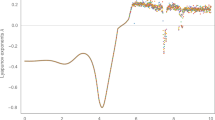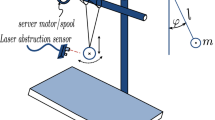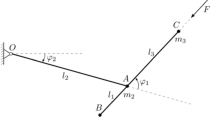Abstract
Nonlinear oscillators are usually utilized by bionic scientists for establishing central pattern generator models for imitating rhythmic motions by bionic scientists. In the natural word, many rhythmic motions possess asymmetric time ratios, which means that the forward and the backward motions of an oscillating process sustain different times within one period. In order to model rhythmic motions with asymmetric time ratios, nonlinear oscillators with asymmetric forward and backward trajectories within one period should be studied. In this paper, based on the property of the invariant set, a method to design the closed curve in the phase plane of a dynamic system as its limit cycle is proposed. Utilizing the proposed method and considering that a cardioid curve is a kind of asymmetrical closed curves, a cardioid oscillator with asymmetric time ratios is proposed and realized. Through making the derivation of the closed curve in the phase plane of a dynamic system equal to zero, the closed curve is designed as its limit cycle. Utilizing the proposed limit cycle design method and according to the global invariant set theory, a cardioid oscillator applying a cardioid curve as its limit cycle is achieved. On these bases, the numerical simulations are conducted for analyzing the behaviors of the cardioid oscillator. The example utilizing the established cardioid oscillator to simulate rhythmic motions of the hip joint of a human body in the sagittal plane is presented. The results of the numerical simulations indicate that, whatever the initial condition is and without any outside input, the proposed cardioid oscillator possesses the following properties: (1) The proposed cardioid oscillator is able to generate a series of periodic and anti-interference self-exciting trajectories, (2) the generated trajectories possess an asymmetric time ratio, and (3) the time ratio can be regulated by adjusting the oscillator’s parameters. Furthermore, the comparison between the simulated trajectories by the established cardioid oscillator and the measured angle trajectories of the hip angle of a human body show that the proposed cardioid oscillator is fit for imitating the rhythmic motions of the hip of a human body with asymmetric time ratios.









Similar content being viewed by others
References
Grillner S (1985) Neurobiological bases of rhythmic motor acts in vertebrates. Science 228(4696):143–149
Hodgkin AL, Huxley AF (1952) Currents carried by sodium and potassium ions through the membrane of the giant axon of Loligo. J Physiol 116(4):449–472
Pinto CMA, Santos AP (2011) Modelling gait transition in two-legged animals. Commun Nonlinear Sci Numer Simul 16(12):4625–4631
Matsuoka K (1987) Mechanisms of frequency and pattern control in the neural rhythm generators. Biol Cybern 56(5–6):345–353
Fukuoka Y, Kimura H, Cohen AH (2003) Adaptive dynamic walking of a quadruped robot on irregular terrain based on biological concepts. Int J Robot Res 22(3–4):187–202
Awrejcewicz J, Pyryev Y (2005) Chaos prediction in the doffing-type system with friction using Melnikov’s function. Nonlinear Anal Real World Appl 2(1):12–24
Bhuiyan MSH, Choudhury IA, Dahari M (2015) Development of a control system for artificially rehabilitated limbs: a review. Biol Cybern 109(2):141–162
Buchli J, Righetti L, Ijspeert AK (2005) A dynamical systems approach to learning: a frequency-adaptive Hopper Robot, 8th European Conference on Artificial Life, Canterbury, England
Righetti L, Buchli J, Ijspeert A (2006) Dynamic hebbian learning for adaptive frequency oscillators. Phys D Nonlinear Phenom 216(2):269–281
de Pina Filho AC, Dutra MS, Raptopoulos LSC (2005) Modeling of a bipedal robot using mutually coupled Rayleigh oscillators. Biol Cybern 92(1):1–7
Nandi GC, Ijspeert AJ, Chakraborty P, Nandi A (2009) Development of Adaptive Modular Active Leg (AMAL) using bipedal robotics technology. Robot Auton Syst 57(6–7):603–616
Wieczorek S (2009) Stochastic bifurcation in noise-driven lasers and Hopf oscillators. Phys Rev E 79(3):036209
Hu YH, Liang JH, Wang TM (2014) Parameter synthesis of coupled nonlinear oscillators for CPG-based robotic locomotion. IEEE Trans Ind Electron 61(11):6183–6191
Rayleigh JWS, Lindsay RB (1976) The theory of sound. Dover Publications, Mineola
Wu YH, Han MA, Chen XF (2004) On the study of limit cycles of the generalized Rayleigh Lienard oscillator. Int J Bifurc Chaos 14(8):2905–2914
Acebron JA, Bonilla LL, Vicente CJP (2005) The Kuramoto model: a simple paradigm for synchronization phenomena. Rev Mod Phys 77(1):137–185
Tsimring LS, Rulkov NF, Larsen ML (2005) Repulsive synchronization in an array of phase oscillators. Phys Rev Lett 95(1):1–4
Van der Pol B, Van der Mark J (1928) The heartbeat considered as a relaxation oscillation, and an electrical model of the heart. Philos Mag 6(38):763–775
Bi QS (2004) Dynamical analysis of two coupled parametrically excited van der Pol oscillators. Int J Non-linear Mech 39(1):33–54
Ijspeert AJ, Crespi A, Ryczko D (2007) From swimming to walking with a salamander robot driven by a spinal cord model. Science 315(5817):1416–1420
Zielinska T (1996) Coupled oscillators utilized as gait rhythm generators of a two-legged walking machine. Biol Cybern 74(3):263–274
Buchli J, Righetti L, Ijspeert AJ (2006) Engineering entrainment and adaptation in limit cycle systems—from biological inspiration to applications in robotics. Biol Cybern 95(6):645–664
Chatterjee S, Dey S (2013) Nonlinear dynamics of two harmonic oscillators coupled by Rayleigh type self-exciting force. Nonlinear Dyn 72(1–2):113–128
Suchorsky M, Rand R (2009) Three oscillator model of the heartbeat generator. Commun Nonlinear Sci Numer Simul 14(5):2434–3449
Murray MP, Drought AB, Kory RC (1964) Walking patterns of normal men. J Bone Jt Surg 46(2):335–360
Wu QD, Liu CJ, Zhang JQ, Chen QJ (2009) Survey of locomotion control of legged robots inspired by biological concept. Sci China Ser F Inf Sci 52(10):1715–1729
Righetti L, Ijspeert AJ (2008) Pattern generators with sensory feedback for the control of quadruped locomotion. In: Proceedings of the IEEE international conference on robotics and automation, Washington, pp 819–824
Xu L, Wang DH, Fu Q, Yuan G, Hu LZ (2016) A novel four-bar linkage prosthetic knee based on magnetorheological effect: principle, structure, simulation and control. Smart Mater Struct 25(11):115007
Fu Q, Wang DH, Xu L, Yuan G (2017) A magnetorheological damper based prosthetic knee (MRPK) and the sliding mode tracking control method for the MRPK based lower-limb prosthesis. Smart Mater Struct 26(4):045030
Acknowledgements
This work has been partialy supported by the LPMT, CAEP (Grant No. 2015-01-001), the National Natural Science Foundation of China (Grant No. 51675070), and the Fundamental Research Funds for the Central Universities (Project No. CDJZR12 12 00 05)
Author information
Authors and Affiliations
Corresponding author
Additional information
Communicated by J. Leo van Hemmen.
Rights and permissions
About this article
Cite this article
Fu, Q., Wang, D.H., Xu, L. et al. A cardioid oscillator with asymmetric time ratio for establishing CPG models. Biol Cybern 112, 227–235 (2018). https://doi.org/10.1007/s00422-018-0746-1
Received:
Accepted:
Published:
Issue Date:
DOI: https://doi.org/10.1007/s00422-018-0746-1




